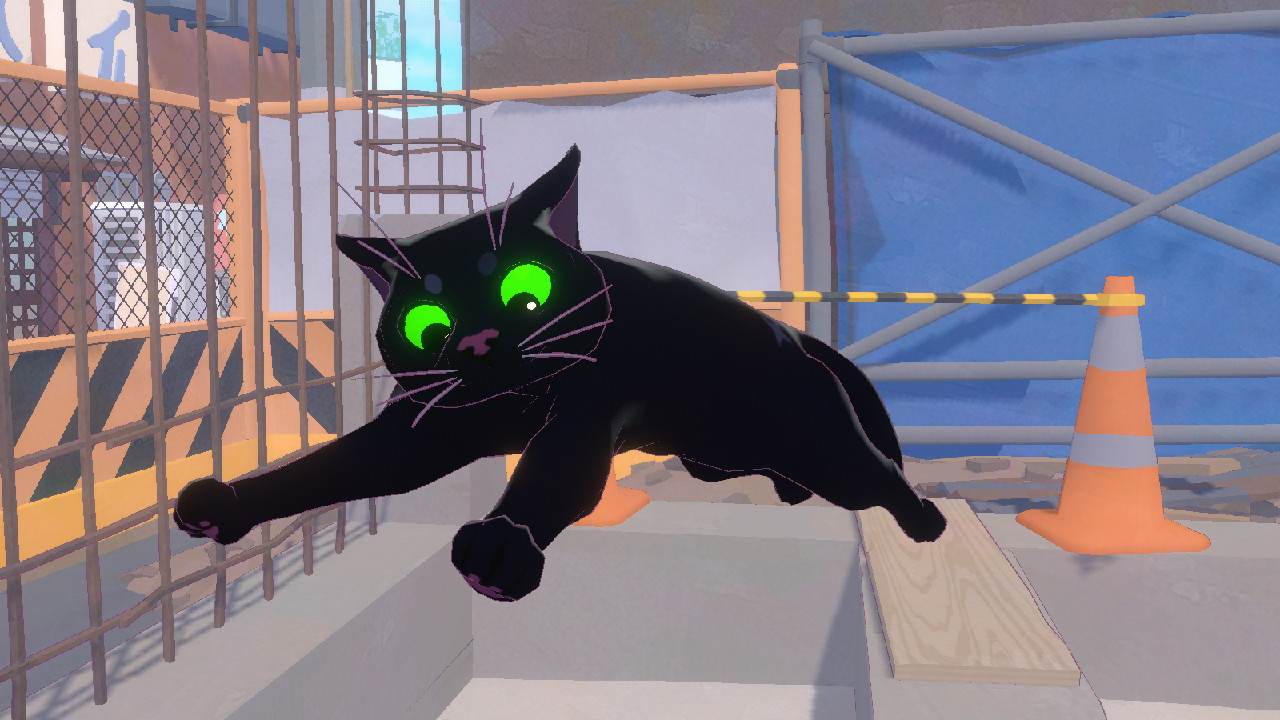The “animal goes wild” subgenre of video games is usually focused on chaos in an open world, be it Goat Simulator or Squirrel with a Gun. But genres can be very wide, and can take a basic premise in other directions. Little Kitty, Big City takes the concept of playing as a cat lost in a city, and turns it into a mellow, nonviolent metroidvania.
While some animal games are more unrealistic and exaggerated, Little Kitty, Big City is a bit more grounded, though with its share of cartoon logic and video game logic. You can earn and upgrade the ability to climb ivy, though not anything else. You can curl up and sleep in sunbeams, enter boxes, crawl under holes, and grab heavy things with your mouth to pull them. There’s even a meow button. Holding that button brings up a list of emotes such as sleeping or stretching.
Probably the game’s most unique feature is the way it handles jumping. Pressing the jump button gives you a short hop. Holding it, however, presents you with a double paw-shaped cursor that shows where you’ll land. You can then aim that cursor to aim jumps precisely, as the cat gets into a “preparing to leap” animation, and then take that leap. It really adds to the feel that you’re specifically controlling a cat that, much like a real cat, scopes out the situation and plans out its jumps before making them.
The whole “you are a cat” feel extends to pretty much the entire game, including your full list of abilities and the things that you’re able to do.
These things include swiping your paws left and right, crawling slowly and deliberately, running forwards in a charge and grabbing things with your mouth. All of these aren’t just for show but are used in the actual gameplay. You can knock over plants just for fun, but sometimes knocking something over is actually required for a side mission. Crawling allows you to sneak up on birds so you can leap on them to steal their feathers. (This is a very nonviolent game: you simply let birds go and they fly away and drop a single feather.) Charging into buttons presses them. Grabbing things with your mouth is used not only for gentle chaos like stealing people’s phones for fun after you trip them, but also for side missions that require taking something to a character.
Yes, there are side missions and characters. There are other animals in this city that you can talk to, such as a crow, a chameleon, other cats, a dog, birds and more. They all have things they want you to do, in exchange for a reward which is usually minor (there are many hats you can wear) but occasionally important – the crow’s first reward enables you to progress further in the city. What you do to earn that reward is collect random “shinies” – miscellaneous tiny shiny objects you find all throughout the game, ranging from being out in the open to requiring effort to reach.
These characters have a lot to say. That is, they have very long dialogs when you talk to any of them. While the dialog is meant to be funny, it also goes on for so long that the saying “brevity is the soul of wit” comes to mind. If you mash the button to speed through the dialog, you’ll end up choosing whatever your default response is, but that usually affects nothing anyway, except when it’s a yes/no question of “do you want to give me X so I can do Y?” But you can always just talk again and select yes.
There’s no real penalty for skipping through the dialog, so players with less patience for drawn out conversations might decide to do just that, especially as one dialog sequence goes on for so long that it takes a half minute if you’re skipping through it as fast as possible. If the character gave you a side mission, you can simply summon the list of side missions and read the gist of what you’re supposed to do.
The side missions in the game are varied, but are mostly of the “bring X to me” variety. There are some that are different. One requires you to sneak up on and pounce on a particular bird so it will go home. Another involves bringing ducklings home, and each duckling is basically a puzzle in their own right: one won’t stop staring at a video game in an arcade, one won’t stop flying in the air on a jet stream, one won’t stop playing in a puddle in a convenience store – you have to figure out how to stop them so that they’ll join you as you take them home.
Yes, a duckling staring at an arcade game. This game might have realism in some ways, but it also operates on a sort of cartoon logic. In fact, the reason you can’t just go into the puddle to get the duck out, is that your cat has an exaggerated fear of puddles. If you touch a puddle, you instantly jump back. And there are puddles scattered all over the city and even some places indoors. Besides puddles, you’re also afraid of barking dogs and cucumbers. Yup, cucumbers. Look up “cat and cucumber” on YouTube and you’ll see why! (With that said, scaring cats is harmful to their mental health, especially repeatedly, so don’t actually pull that stunt.)
Back to the puddles. Why are they scattered throughout the city? Because this is a metroidvania.
The world is essentially a maze. Gates are closed, ivy can be climbed up but only after you’ve upgraded your climbing ability by eating a fish, and there are holes you can crawl through which are sometimes blocked by a box or flower pot. That last obstacle can be pulled away only once you’ve found a way to the other side, unlocking a shortcut.
But much of navigation in the game is about figuring out how to get places. You see something high up, or something behind a fence, and wonder, “How do I get there?” And you find a roundabout answer to that question, which often involves entering places that only a cat could possibly reach. Or you upgrade your climbing ability to go higher up the ivy. There’s also a form of fast travel – manholes that warp you to other manholes you’ve previously activated by exchanging a bird feather with the tanuki that operates the manholes.
Oh, and why is it a tanuki that operates manholes? Because this US-developed game takes place in Japan. A Japan that uses signs written with a fake language rather than actual Japanese writing, and whose humans’ various grunts and yelps are clearly voiced by Americans.
The game’s art style is a cel-shaded cartoon with outlines, and soft colors. Your nameless cat is very well animated and easily where most of the animation detail went. Every movement from the way the cat looks around when standing still, to the way you crawl, pounce, and even facial animations like the smile when you catch a bird, is smooth and walks the line between the realistic movements of a real life cat and the expressiveness of a cartoon cat.
Meanwhile, humans are faceless and simple looking. Other animals look decent but don’t move as much as the cat does and have far fewer animations.
While this game has side missions and a main goal, it’s still an “animal goes wild” game. So there’s plenty of mischievous things you can do – and in some cases have to do! You can not only trip people and steal things they’ve dropped such as sandwiches (as bait for birds) or phones (required for one side mission), you can do many other things. Steal a fish out of a store and run out of there before the employee catches you, then drop it and eat it once you’re outside. Walk in paint buckets and leave painted footprints on the ground. Step on a computer keyboard and fill up the screen with “cat-like typing.”
Your ultimate goal is to find your way back home. And your home is located very high up, so basically you have to upgrade your climbing abilities and find your way around the city until you’re finally able to get up there. Once you do, you win the game, and can then continue playing simply for fun or to accomplish other side missions.
While Little Kitty, Big City is naturally a product of modern times and the demand for more detailed gameplay with the current popular features, some older audiences might actually get slight vibes of an old retro game, Alley Cat.
Alley Cat was a fast-paced 1983 platformer about controlling a cat who moved through an alley, entered a house, and performed various cat-like activities such as knocking plants off a bookshelf, knocking down a birdcage and catching the bird, and more. It had animation that was rather detailed for its time, with the cat even looking around and meowing if the player stood still. It had a quiet, lightly jazzy soundtrack (at least only the Atari computer version did) playing throughout gameplay that changed slightly depending on the player’s action. Humans did not show up, but things that represented them (such as a broom trying to sweep up your cat prints, or sweep you out the window) did instead, and could serve as obstacles.
The evolution of knocking down potted plants over four decades.
Little Kitty, Big City actually has many of those exact same features! Its focus on detailed animation that mimics how real cats move, range of cat-like activities including knocking over plants and catching birds, a quiet, light jazz soundtrack that changes based on the situation, and humans that sometimes shoo you away or kick you out when you annoy them, can make the game almost feel like a spiritual successor to that obscure retro game made 41 years prior.
Funny how these kinds of things happen. Occasionally a new, very modern game with modern gameplay elements contains the “soul” of a very old game – another example being Treasures of the Aegean and its similarities to Pharaoh’s Curse for the Atari 8-bit computers.
Of course the two games are very different, with Alley Cat being a fast-paced action game with a lives limit and many hazards, and Little Kitty, Big City being a chill metroidvania with no ability to die, with the worst things that can happen being getting kicked out of a store or accidentally missing a jump when very high up and landing safely down on the ground to start over. But the similarities between the two shows one of the interesting quirks of entertainment: old ideas can sometimes resurface in very different forms.
For those thinking of buying it for their child, one thing to be aware of is how verbose the dialog is. If your child skips through it, be prepared to help them at least read the list of side missions, or realize they should talk to the character again and answer yes to whatever the character asked. Aside from that, the confusing maze-like nature of the game might result in some younger players feeling lost and being frustrated at not knowing where they can go, as the game is heavily based around finding out of the way paths and opening up more of the world over time as you unlock shortcuts or upgrade your climbing. These features might bother adult gamers as well.
The other issue with the game is that the movement is a combination of smooth and janky. Jumps frequently result in the game automatically shifting your position if you don’t quit strike the landing. Walking near a bunch of complex level geometry in close proximity to each other results in you being “pushed” a bit. There’s even an “unstick me” button in one of the pause menus, to be used in case of emergencies. Fortunately, getting stuck is ultra rare, especially after multiple patches. Crawling through holes is a bit more exacting, and might require more than one attempt if the first attempt doesn’t register.
The game has its flaws, but it’s also very unique. “Chill metroidvania with no death” is not an especially common subgenre of game, especially not combined with “animal goes wild.” Little Kitty, Big City is one of a kind.

















































